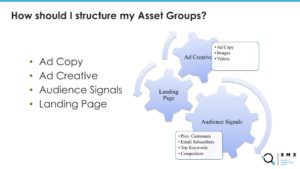It’s been around for more than a year, but Google’s Performance Max is just entering the best part of its lifecycle so far. Thanks to significant usage by leading Google Ads practitioners, this machine learning-oriented campaign is better today than it’s ever been.
Whether you’ve just heard about Performance Max for the first time or you’re still trying to get a grip on it, I’ve got the answers you need: what to look for while setting it up, the differences between ecommerce and lead generation, how to get better results, and what’s new for 2023.
While not exhaustive, you can use this article as a guide to build and optimize your first (or next) campaign. And there are plenty of resources further down to more specific applications for Performance Max, as well as people and teams producing best-in-class content about it.
Let’s get going!
All about Google’s Performance Max
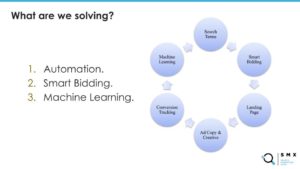
Performance Max allows advertisers to target placements on several Google properties including Search, Shopping, Video, Display, Discovery, Gmail, and Local Services. Campaign creation involves uploading assets, providing audience signals, and setting spend levels. Google’s machine learning handles nearly everything else including:
- Where and when to serve your ads
- Which queries to bid on and for how much
- Real-time auction targeting based on thousands of data points
There are limitations—reporting is not as robust as advertisers are used to, negative keywords can only be applied at the account level, and Performance Max has a tendency to steal traffic from your own standalone campaigns.
But between Google’s ongoing improvements and the tendency of machine learning to make better decisions over time, Performance Max is significantly better today than when it was first released to the public.
Whether you want to build your first Performance Max campaign or optimize one that you’ve already built, this article covers it all.
An overview of Performance Max campaigns
Performance Max campaigns have some limitations in terms of control and granularity. Some actions can only be applied at the account or campaign level, and it can be frustrating trying to get meaningful insights to decide what to do next.
But the very reason for that frustration—a heavily machine learning-dependent model—also means these campaigns perform really well when set up correctly and allowed to run with minimal interference.
Here are some other things every advertiser and media buyer should know about Performance Max.
Which accounts should not run Performance Max
Theoretically, any Google Ads account can run Performance Max; the only prerequisites are conversion tracking and either creative assets or a Merchant Center feed. That being said, some types of accounts will struggle to get results because of the campaign’s heavy reliance on machine learning:
- New and young accounts with zero or few historical conversions
- Miniscule budgets (less than $1,000 a month)
- Insufficient conversion volume (fewer than 30 per month)
- Poor product data feed in Google Merchant Center (ecommerce only)
Not having some way to enrich the system’s decision-making ability is also a sign that you may struggle. I cover this in more detail further down in the section about viability.
Create your campaign structure
Under Performance Max, campaigns are made up of asset groups containing multiple assets or listing groups (for campaigns with an associated merchant feed). Assets may include text (headlines, descriptions, callouts/extensions); images; or videos. Listing groups are organized by the attributes assigned to them in your feed.
Here’s a sample Performance Max campaign structure for a home contracting business.
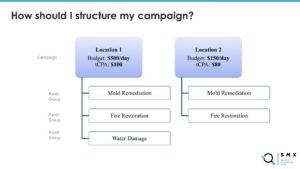 Performance Max allows a single campaign to serve multiple needs, with each asset group built around a service or theme. This campaign can then be duplicated to target different locations (e.g. by zip code or county) or audiences (such as new customers only).
Performance Max allows a single campaign to serve multiple needs, with each asset group built around a service or theme. This campaign can then be duplicated to target different locations (e.g. by zip code or county) or audiences (such as new customers only).
Create your campaign assets
Performance Max campaigns have three categories of assets:
- Ad text, usually in the form of a responsive search ad
- Creatives, whether static or video
- Extensions, now confusingly referred to as assets
Ad text will typically be a combination of headlines and descriptions, and Google will mix and match these to find the best performing combinations. You can pin elements to certain positions if you want or need, but then you lose out on the biggest strength of Performance Max. So instead of filling out all 15 headlines, write about half of them—this puts you between the minimum of 3 and the maximum, which might require too long of a testing phase.
For still and moving images, you’ll want to prioritize the ability to stop a scroll. That means vivid, attractive photo assets and videos with powerful hooks. DTC ecommerce advertisers do a fantastic job with these hooks, making Performance Max a natural extension for them to enter the world of Google Ads.
Extensions are now known as assets, but their functionality remains largely unchanged. You can add sitelinks, calls to action, promotions, prices, phone numbers, structured snippets, and more. These give your ad greater detail and visibility in the SERP, potentially making the difference between an impression and a click.
Setting your bid strategy
Creating a Performance Max campaign means you’re opting in to Smart Bidding, thus giving you two options: Maximize Conversions and Maximize Conversion Value.
My recommendation is almost always the same: Begin with Maximize Conversions and allow the system to build as much conversion data as possible. Having good audience signals will speed this up, but there’s still going to be a learning period of around 6 weeks with any new Performance Max campaign.
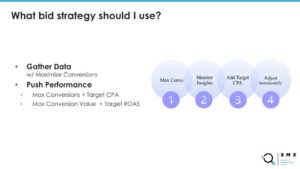 Once conversions are coming through at a rate and quality you’re happy with, consider adding a Target CPA to keep costs in check. You could also switch to Maximize Conversion Value at this point with a Target ROAS. Keep in mind that being too restrictive will reduce conversions and therefore revenue, while being too generous will affect margins and therefore profitability. You’ll need to experiment to find that ideal target.
Once conversions are coming through at a rate and quality you’re happy with, consider adding a Target CPA to keep costs in check. You could also switch to Maximize Conversion Value at this point with a Target ROAS. Keep in mind that being too restrictive will reduce conversions and therefore revenue, while being too generous will affect margins and therefore profitability. You’ll need to experiment to find that ideal target.
Selecting audiences
The biggest difference between audiences in Performance Max and other campaigns like Search is how closely Google adheres to a list.
For example, targeting a remarketing campaign with a list of 10,000 users means Google will show your ads to those 10,000 individuals as they travel around the internet. That same list in Performance Max is a signal, and Google will consider these “ideal” users but may not pursue them specifically.
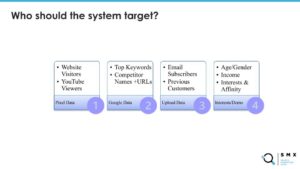
Instead, it’ll analyze those 10,000 users based on its thousands of data points. Once it understands what connects them on a deeper level, it will go after people who share those traits or behaviors. The original 10,000 may or may not fall under this new category. Either way, Performance Max quickly goes past your initial signals and develops its own based on actual campaign performance.
Target and exclude keywords
While you can now apply negative keywords directly without the help of a Google Ads rep, you can still only do so at the account level.
The good news is that if your Performance Max campaign is targeting the same keyword as one of your Search campaigns, the Search campaign will take precedence when the query and keyword are identical (remember, Exact Match can go a bit wider than a perfectly identical query).
Optimizing your product feed
Forgetting to optimize your merchant feed is a common but expensive mistake. If you’re planning to include the Shopping network in your Performance Max campaign, a suboptimal feed will cost you. Fortunately, feed optimization is based on a hierarchy of attributes and follows a few simple rules.
- You should prioritize product titles, pricing, and category information.
- Titles need to be keyword-driven. This is what Google primarily uses to determine which queries to show your products for, so more descriptive titles allow your products to qualify for more auctions.
- Inserting brand names will open you up to serving for those branded searches. Don’t do this unless you’re specifically targeting that traffic.
- If you leave your category fields empty, Google will automatically fill them in. This isn’t always the most accurate
Setting and excluding locations
When you pick the locations for a Performance Max campaign to target, there are a couple of options to be aware of:
- Presence only uses location data to show your ads to people who are physically in your target geographic area, or who spend significant time there.
- Presence and interest expands targeting to include people who may be searching for things in your targeted geographic area,
It’s the difference between showing your ad to someone in the United States versus someone who might be planning a trip there. If you want to limit your targeting to a geographical area, make sure you select presence only. Google recommends presence and interest, but that doesn’t always suit advertiser needs.
Picking landing pages
Final URL expansion is an optional setting that allows Google more freedom to decide which pages to send visitors to, using on-page content to make that decision based on a given query and search intent.
The latest changes to Performance Max allow you to build a page feed and give Google a list of landing pages to send people to. You can still exclude any pages that don’t perform well or that you don’t want ad clicks directed to.
Final URL expansion isn’t available for campaigns with store goals only.
With Google, however, nothing remains the same for long. Other PPC experts and I have seen that in some accounts, you can only disable URL expansion if you enable automatically created assets.
Seems Google is testing the “Automatically created assets” setting for Performance Max campaigns.
In some accounts, it’s replacing the “Final URL expansion” setting. cc @rustybrick #ppcchat pic.twitter.com/QdX9cuxFCp
— Dennis Moons 🧪 (@DennisMoons) June 8, 2023
When Performance Max becomes most viable
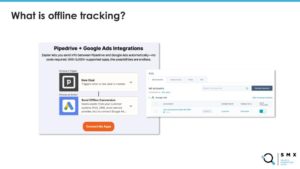 Because so much of Performance Max runs on machine learning, the best and fastest path to optimization is going to be the quality of your data—both within and outside of Google.
Because so much of Performance Max runs on machine learning, the best and fastest path to optimization is going to be the quality of your data—both within and outside of Google.
- Audience signals at creation give Performance Max a clear starting point.
- Segment campaigns and asset groups by theme or service for added granularity.
- The longer your campaign runs, the more accurate it becomes.
- Qualify leads to be more discerning with which conversions you bid against.
- Pass offline conversion data from your CRM, IVR, or other systems back to Google.
Done right, Performance Max is capable of getting great results. This is especially true for ecommerce, which has revenue data baked in by default and is easier to launch on Performance Max (lead gen requires you to feed in sales data before you can use it).
Ecommerce advertisers can of course run Standard Shopping campaigns with Target ROAS bidding, but you lose the in-built retargeting and algorithmic nature of Smart Shopping that made this network so strong in recent years.
If you can’t or don’t want to do the work of using commercial and offline data to optimize Performance Max, you probably won’t maximize your potential with this campaign. And that’s okay, but it means you’re probably better off running a data feed and bid-driven Standard Shopping campaign.
The step-by-step guide to creating and optimizing Performance Max campaigns
Not only do I think Performance Max is a viable campaign type, I’ve documented what I’ve learned as I’ve grown more comfortable with its capabilities and limitations. Follow along with this in-depth, three-part guide:
- How to set up Performance Max campaigns the right way: A detailed walkthrough of everything you should do while creating a Performance Max campaign.
- How to maximize insights from Performance Max: Learn how to pull data and insights from your Performance Max campaigns to inform future decisions.
- How to optimize Performance Max for better results: All the ways to get your Performance Max campaigns closer to optimal performance, in full detail.
And for my thoughts on different angles and applications of Performance Max:
- How to make the most of Performance Max this holiday shopping season: Written for the 2022 holiday season, but the frameworks and philosophies are still relevant as you plan for Q4 of 2023.
- Avoid the 7 mistakes that tank retail Performance Max campaigns: I’ve seen ecommerce Performance Max campaigns flop, even with great products and big budgets. Here’s why that happens.
- Why Performance Max for lead generation often fails and how to make it work: Lead gen accounts may find it especially tricky to get Performance Max to click. If that’s you, here’s what you may be doing wrong.
- Why Facebook advertisers should test Performance Max: Direct-to-consumer (DTC) ecommerce primarily relies on Meta Ads, but they’re probably better equipped for Performance Max than they realize.
- How to think about brand exclusions for Performance Max: With the new campaign level brand exclusions in beta testing (including at JXT Group), here’s my argument for why it may not always be the right choice.
The limitations of Performance Max
No campaign or ad platform is perfect. While there are plenty of reasons to look forward to your next Performance Max campaign, you should be aware of its limitations. Here’s the most important information to keep in mind.
Advice for PPC marketers and media buyers
- When creating a Performance Max campaign, Google will auto-generate any asset types you don’t upload. You’re probably best served creating your own, disabling the asset types you don’t want (e.g. video), or letting them auto-generate and then removing them.
- Auto-apply recommendations are hit or miss, and even more unpredictable with Performance Max’s moving parts. Make sure you read Google’s recommendations carefully before enabling them, and only do so if you fully understand the outcomes.
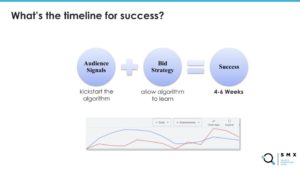
- Every Performance Max campaign has a learning phase after creation, where it gathers information on what works and what doesn’t. Audience signals and historical conversion data speed this up but can’t replace it. Keep changes to a minimum for the first 4-6 weeks and be prepared to write the spend off as a (necessary) data-gathering investment.
Recommendations for advertisers and business owners
- Your team doesn’t have the level of control in Performance Max that they do with Search or Standard Shopping. From bidding strategy to excluding keywords and all the way down to reporting, you will need to get used to reduced visibility and control. The tradeoff is potentially a much higher conversion value and profit-optimized campaigns.
- More so than other campaigns, Performance Max success is influenced significantly by optimizations that happen outside the ad account. Support your team or agency as they strive for strong creative and video assets, responsive landing pages with clear and relevant copy, and zoomed-out attribution.
- Success comes down to trust in your team or agency. They’re the ones working to create growth for your business, so allow them to lead the strategy. It doesn’t mean you shouldn’t expect transparency and communication, but don’t allow third parties (even verified ones) to derail the plan your media buyers put together with care.
Major differences between ecommerce vs. lead generation
As with everything else in Google Ads, ecommerce has greater scope in Performance Max. You can be more creative with campaign structure, try more optimizations, and generally get better results due to the nature of conversions. Lead generation is more straightforward to set up but requires a lot of care with the quality of data.
Here are some of the more noteworthy differences.
- Ecommerce has to deal with the added workload of managing a product feed in the Merchant Center, and neglecting this can be more disastrous than it is for Standard Shopping.
- Lead generation struggles with conversion quality, especially without any first-party data to teach the system what your business leads. Ecommerce gets the benefit of conversions being financial transactions.
- Smaller lead generation accounts will struggle if they have insufficient conversion volume (at least 30 per month). With Local Service ads now in Performance Max, this can be a tough paradox for small advertisers who want to advertise on that inventory.
- Ecommerce accounts running both Performance Max and Standard Shopping will observe cannibalization of traffic from the latter to the former. This is why I recommend splitting categories up rather than running them on both campaigns.
- Lead generation optimizations are typically done outside of the Google Ads account for Performance Max: offline conversion data, qualifying leads, copywriting for landing pages. Newer accounts will need to build Search campaigns to gather data before trying Performance Max.
- Ecommerce still benefits from offline conversion data and a great landing page experience, but has more scope to optimize within the account. Examples include campaign structure, category splits, and using Standard Shopping for more control.
Google’s 2023 updates to Performance Max
Earlier this year, Google announced several new changes to how advertisers and media buyers can use Performance Max. This is a welcome step and shows that Google is listening to what more platform-savvy marketers are saying. I’m fully confident that we’ll get new capabilities as time goes by.
Google has a detailed breakdown of these new capabilities, but here’s a click-saving rundown.
- A stronger relationship between Search and Performance Max that Google calls the “Ads Power Pairing”.
- The ability to apply negative keywords directly without going through a Google Ads support representative, albeit only at the account level.
- Brand exclusions at the campaign level. JXT Group is currently a beta tester for this feature and unable to reveal further details.
- Groups of potential landing pages known as Page Feeds. They inform but do not limit landing page selection with URL expansion set on.
- Dedicated experiments to measure incremental lift in Performance Max campaigns.
- A new video creation tool to help advertisers without pre-built assets exert greater control over brand safety.
- The highly requested and very welcome asset group report, along with budget pacing insights.
Resources, content, and further reading
If Performance Max still seems confusing, it’s probably because of the interactions available to advertisers and media buyers. The campaign itself is one of the simplest, low-touch innovations from any digital ad platform.
I share everything I learn about Performance Max on Search Engine Land and the JXT Group blog.
Follow me on Twitter where I post threads on Performance Max as well as the wider world Google Ads.
More education is always good, so if you’re looking for people and teams to follow, here are the ones who have my personal endorsement.
Google Ads experts
- Jakub Bendlewski, Head of Marketing, MTA Digital
- Duane Brown, Founder, TakeSomeRisk
- Ginny Marvin, Ads Product Liaison, Google
- Mike Ryan, Head of Ecommerce Insights, Smarter Ecommerce (SMEC)
- Collin Slattery, Founder, Taikun Digital
- Kirk Williams, Owner, ZATO Marketing
YouTube and podcasts
- Google Ads official YouTube channel
- Marketing O’Clock by Cypress North
- Paid Media Pros by Joe Martinez and Michelle Morgan
- PPC Town Hall by Optmyzr
- The Google Pro by Jyll Saskin Gales


